



Guide to Determine What Weight Show Pig to Buy
A guide to purchasing and feeding a pig so that it reaches the correct weight on show day by Dr Mark A. Crenshaw, Extension Professor at the Department of Animal and Dairy Sciences at Mississippi State University.Traditionally, the swine show at the Dixie National Livestock Show is scheduled for a Saturday near 1 February each year. In 2014, the Dixie National Junior Roundup Swine Show is scheduled for Saturday 1 February.
Each year, many swine exhibitors purchase the pigs they intend to show at the Dixie National Junior Roundup in Jackson. Some exhibitors purchase pigs at show pig sales, on-farm sales, or from individual producers usually in late September and October. Sometimes they purchase in early November, since the ownership deadline for pigs is 1 December. Don't wait until November to purchase a pig, because there may not be many left.
To be successful showing pigs, plan before purchasing the show pig.
1. It is a good idea to understand the show requirements.
- Become familiar with the rules and regulations of the specific show in which you will show the animal.
- Each show may have different requirements, and the requirements may change from one year to the next.
- Mississippi Bred Contest: If you want to be eligible for additional premiums provided by the Mississippi Pork Producers Association for Mississippi-bred tagged pigs, ask the seller if the pig will be tagged Mississippi-bred before you purchase the pig. All Mississippi-bred tagged pigs should be tagged before change of ownership.
2. Here are more things to consider before purchasing the show pig:
- Animal care - who will provide daily care for the pig?
- Housing - do you have a shelter and pen to keep the pig comfortable?
- Transport of the pig - do you have a truck or trailer to haul the pig(s) you purchase?
- Equipment - do you have a self-feeder and water supply for the pig?
- Feed - what will you feed your pig, and will you have the feed when the pig arrives?
- Health programme - ask the seller what vaccinations or wormers the pig has received and when the treatments were given.
- Market situation - what do you plan to do with your pig after the show?
- Sources of show pigs - where will you go to purchase a show pig?
How to Use the Tables
The following tables will help you determine what weight pig to purchase at various times. Each table is for a different purchase date (September through November). The purchase date is listed at the top left side. Also, the number of days to the show date (1 February) is listed on the top row after the pig purchase weight. Be sure you use the table that matches your pig purchase date.
Table 1 – Purchase date, 1 September
Table 2 – Purchase date, 15 September
Table 3 – Purchase date, 1 October
Table 4 – Purchase date, 15 October
Table 5 – Purchase date, 1 November
Table 6 – Purchase date, 15 November
Approximate Show Pig Weight Tables
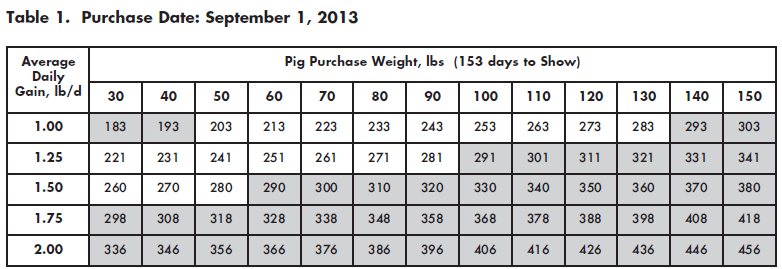
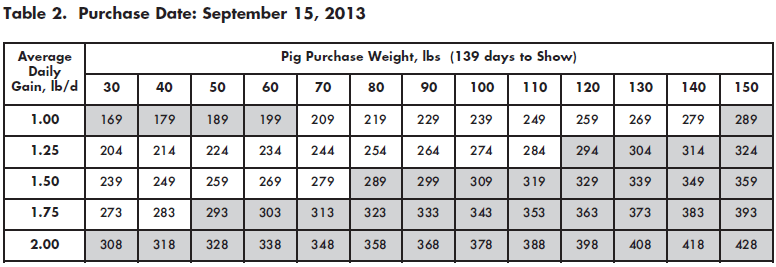
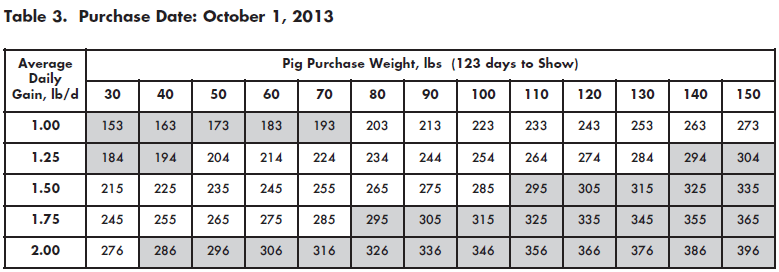
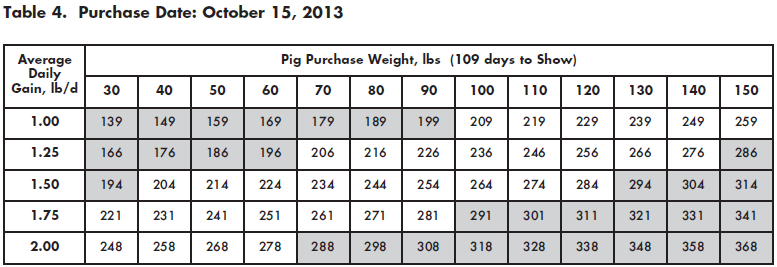
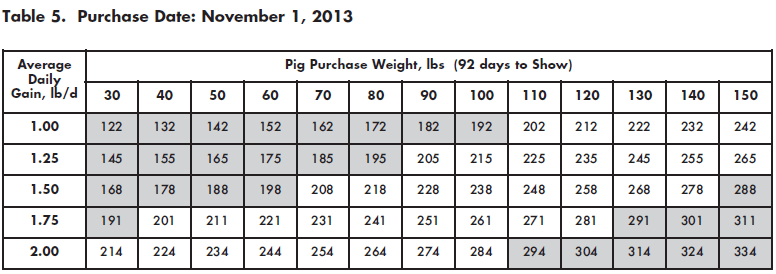

The shaded areas in each table represent pig weights that are outside the desirable weight ranges for the Dixie National Junior Roundup. Pigs must weigh 200 pounds or more at the show. There is no maximum weight for the pigs, but weights above 285 pounds are shaded in the tables.
There are different ways to use these tables. One way, if you know the weight of the pig you want to buy, is to locate that weight on the top row of the table, then locate the expected average daily gain (ADG) in the column on the left side of the table. The number at the intersection of the row and column is the projected weight of the pig on 1 February 2014.
Example: Table 2. Purchase Date: 15 September - You found a pig you want to purchase. The pig weighs 50 pounds, and you think the pig will gain 1.5 pounds per day. The projected weight of the pig on 4 February is 259 pounds.
Another method, if you know what weight you would like your pig to weigh at the show, is to locate that weight in the unshaded area of the table along the same row you think the pig will gain (ADG), then go up the column from the desired show weight to find what weight pig you need to purchase (pig purchase weight).
Example: Table 3. Purchase Date: 1 October - You want your pig to weigh about 275 pounds at the show, and you estimate the pig will gain 1.75 pounds per day. From the 275-pound value located in the 1.75-pound row, go up the column to the top row (pig purchase weight) and determine a 60-pound pig is what you need to purchase 1 October.
Also in this same table with the same show weight of about 275 pounds, there are other pigs with a similar weight. For instance, if you purchased a 90-pound pig 1 October, you have to make sure the pig gains no more than 1.5 pounds per day to weigh 275 pounds on the show date. And a 120-pound pig purchased on 1 October needs to gain only 1.25 pounds per day to weigh 274 pounds on 1 February 2014.
Example: How to calculate a projected pig weight for the show date
If you want to calculate the projected pig weight for a specific date not listed in the above tables, the following example should be helpful.
Item 1: First, determine how many days it will be from the date of purchase to the show date.
From 1 October to 1 February, there are 123 days (see Table 7).

Item 2: Next, find out the weight of the pig you plan to purchase.
The seller may provide this information, or you can estimate the weight or weigh the pig on a scale.
Starting pig weight is 50 pounds.
Item 3: Next, determine how many pounds of gain per day (ADG) the pig will average until the show.
This will vary depending on the genetic potential of the pig, health status, type and quality of feed, amount of feed provided to the pig each day, housing conditions, weather factors, and so forth. Pigs will grow better if they are not alone. Normally, a pig should gain within a range of 1.4 to 2.0 pounds per day. Example 1.75 pounds.
Generally, from 60 to 110 pounds, a pig will eat about five pounds of feed per day and should gain about 1.5 pounds per day. As the pig approaches 200 pounds, it will eat about eight pounds of feed per day and should gain about two pounds per day.
Item 4: Last, calculate the estimated weight of your pig on the show date.
Multiply Item 1 by Item 3, then add the answer to Item 2; this value is the estimated pig weight on the show date.
Example calculation:
Item 1 = 123 days until show
Item 2 = 50 pounds, initial pig weight
Item 3 = 1.75 average daily gain
Item 4 = 265 pounds of weight on show date
(Item 1 × Item 3) + Item 2 = Item 4.
(123 days × 1.75 lb ADG) + 50 lb pig = 265-lb pig at the show
A show weight calculator to assist with the purchase and growth management of your show pig is available in an excel spreadsheet. Go to msucares.com/livestock/swine/index.html and scroll down the page to 'Other Information'.
Summary
Careful attention to the pig’s growth rate can identify other management practices that may need attention.
If the rate of growth is less than you expect, consider other influences you may need to address, such as health status, animal comfort (housing conditions) and dietary concerns.
The information in this publication can help you monitor and adjust the growth of the pig throughout the feeding period before the show.
Purchasing a show pig that is the correct weight for the intended show gives you a good beginning to your swine project.
December 2013








